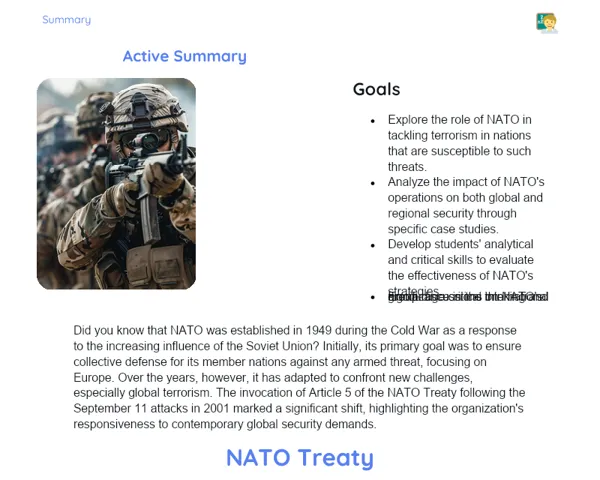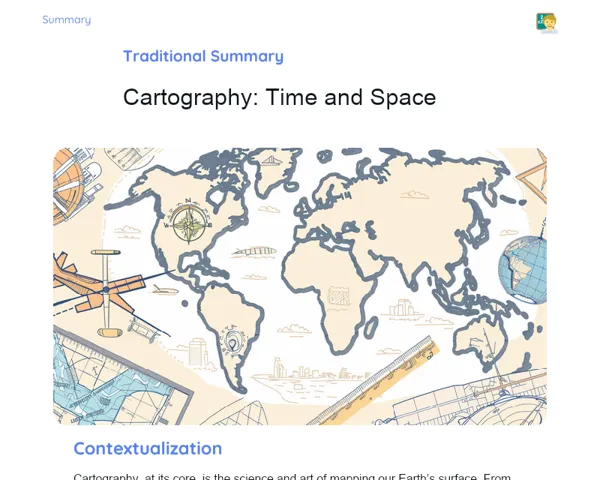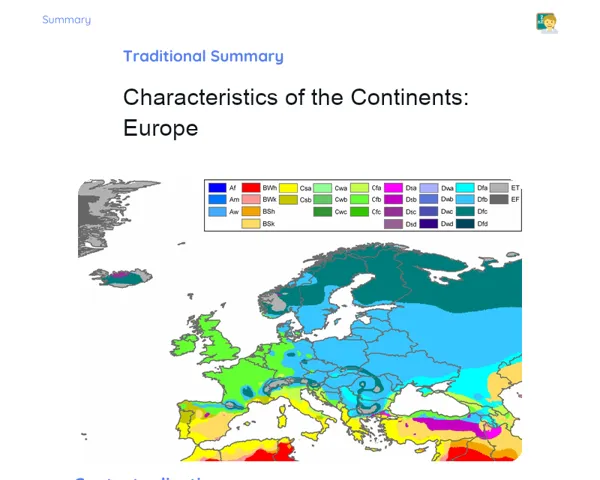Summary Tradisional | World: Nation-State Economics
Contextualization
The economy serves as a vital foundation for the development of any nation. It has a direct impact on the quality of life for its citizens, political stability, and the country's capability to engage within the global community. By grasping the nuances of economic functioning, we can better analyze the news we consume, government policies, and the realities we confront in our daily lives. For instance, indicators like GDP (Gross Domestic Product) and HDI (Human Development Index) are critical in assessing the economic and social development of nations, enabling accurate comparisons and insights.
Different countries have unique ways of organizing their economies, drawing on their specific characteristics and natural resources. For example, Brazil is a major exporter of agricultural products, while Japan excels in high-tech exports. This specialization showcases the strategies employed by governments aimed at fostering economic growth and prosperity. Understanding the interplay between politics, economy, population, and production is crucial in comprehending the challenges and opportunities faced by nation-states on the global platform.
To Remember!
Economic Policy
Economic policy encompasses the actions and strategies implemented by governments to navigate a country's economy. It is vital for steering economic growth, managing inflation, unemployment, and other key indicators. Economic policies can be categorized into various types, such as fiscal policy, monetary policy, exchange rate policy, and trade policy.
Fiscal policy deals with managing revenue (taxes) and public expenditure. Governments have the option to raise or lower taxes or tweak public spending levels to influence the economy. For instance, during a downturn, a government might opt to boost public spending to revive economic activity.
Monetary policy, conducted by the central bank, focuses on regulating the money supply and interest rates. Adjustments in interest rates can sway levels of consumption and investment within the economy. Exchange rate policy involves handling the value of the national currency against others, whereas trade policy governs international trade rules, including tariffs and trade agreements.
Every type of economic policy has a distinct role in achieving economic stability and fostering growth. The success of these policies often hinges on various factors, including the prevailing economic climate, the country's economic framework, and global circumstances.
-
Economic policy is crucial for steering economic growth and stability.
-
Fiscal policy pertains to managing government revenues and expenditures.
-
Monetary policy is overseen by the central bank and regulates the money supply and interest rates.
Economy and Population
The interplay between a nation's economy and its population is intricate and layered. Population growth can either propel or thwart economic advancement, largely depending on the management and distribution of resources. An upward shift in population can widen the consumer base, offering enhanced prospects for businesses.
Nevertheless, rapid population growth may also exert pressure on public utilities and infrastructure, one that encompasses health, education, and transportation. If economic growth doesn't keep pace, issues like unemployment and inequality could intensify, further complicating socio-economic challenges.
A rising population demands more jobs, housing, food, and various services. Consequently, both government and private enterprises need to invest consistently in infrastructure and job creation to meet this increasing demand.
Thus, proficient management of the relationship between economy and population is essential. Public policies that champion sustainable economic development and social inclusion are key to ensuring that population growth yields tangible economic and social dividends.
-
Population growth can enhance the consumer market.
-
Increased pressure on public services and infrastructure may arise.
-
Effective management is vital to turn population growth into advantages.
Production and Economic Sectors
Economic production within a country is categorized into three primary sectors: primary, secondary, and tertiary. The primary sector consists of activities like agriculture, mining, and fishing, which extract and provide raw materials — a foundational element for the economy.
The secondary sector is focused on converting these raw materials into finished or semi-finished products. It includes manufacturing, construction, and other activities that enhance value to basic inputs. This sector is pivotal for driving economic development by creating jobs and fostering industrial growth.
The tertiary sector, dubbed the service sector, covers activities that offer services rather than tangible products, such as trade, transportation, healthcare, education, and financial services. This sector has experienced substantial growth in modern economies, signaling a shift towards service-oriented structures.
Economic diversification, which is the balanced representation of production across these sectors, is crucial for sustaining economic stability. Countries that heavily depend on just one sector are more susceptible to economic upheavals. Diversification empowers a nation to withstand global and regional economic shocks.
-
The primary sector engages in the extraction of raw materials.
-
The secondary sector transforms raw materials into finished goods.
-
The tertiary sector provides services such as trade and transportation.
Globalization and International Trade
Globalization is a process that enhances the interconnectedness of economies worldwide, propelled by international trade, foreign direct investments, migration, and technological advancements. It profoundly impacts the economies of nation-states, presenting both opportunities and challenges.
A significant advantage of globalization is the upsurge in international trade. Countries can focus on producing goods and services based on their comparative advantages, trading them for other necessities. This can result in a more efficient allocation of global resources and improved economic health.
However, globalization poses significant challenges as well. Economic interdependence means that a crisis in one country or region can swiftly ripple out to others around the globe. Also, local industries might struggle against foreign competitors due to increased global competition.
Economic blocs like the European Union (EU) and Mercosur have emerged to ease trade among member nations by reducing tariffs and standardizing regulations. Such trade agreements can bolster the economies of participating nation-states but necessitate economic and social adjustments.
-
Globalization fosters integration among global economies.
-
It encourages international trade and specialization.
-
Economic crises can proliferate quickly due to interdependence.
Economic Indicators
Economic indicators are metrics that gauge the health and performance of a nation’s economy. They are essential tools for policymakers, investors, and the general populace. Some key indicators include Gross Domestic Product (GDP), Human Development Index (HDI), unemployment rate, and inflation.
GDP represents the total value of all goods and services produced within an economy over a specific period. It helps in assessing the size and vitality of an economy. A rising GDP is often a sign of economic expansion, while a falling GDP might indicate a recession.
The HDI is a composite measurement that encapsulates human development across three dimensions: longevity, access to knowledge, and living standards. It provides a more comprehensive lens of development beyond just economic metrics by integrating social elements.
The unemployment rate and inflation also serve as crucial indicators. The unemployment rate reflects the share of the labor force that is without jobs but actively seeking work. Inflation measures the rate at which prices of goods and services escalate over time. Both indicators have substantial implications for economic strategies and the welfare of citizens.
-
Economic indicators evaluate the overall health and performance of the economy.
-
GDP quantifies the total value of goods and services produced.
-
HDI assesses human development from various perspectives.
Key Terms
-
Economy: The study of how individuals and societies allocate scarce resources to produce and distribute goods and services among different people.
-
Nation-States: Political entities marked by defined territory, a permanent population, a government, and the capacity to engage with other states.
-
Economic Policy: A collection of actions and strategies chosen by governments to steer a country’s economy.
-
Population: The collective of individuals residing in a certain territory.
-
Production: The act of generating goods and services.
-
Economic Sectors: Divisions of the economy classified into primary, secondary, and tertiary sectors.
-
Globalization: The integration of economies worldwide.
-
International Trade: The exchange of goods and services between nations.
-
Economic Indicators: Metrics deployed to gauge the health and functioning of the economy.
-
GDP: Gross Domestic Product; a measure of the total value of goods and services generated within an economy.
-
HDI: Human Development Index; a composite measure reflecting human development.
-
Inflation: The rate of increase in the prices of goods and services over time.
-
Economic Diversification: The balanced representation of production across diverse sectors of the economy.
Important Conclusions
The economy of nation-states is a vital topic for understanding the growth and stability of nations. This lesson has delved into how economic policies, the interplay between economy and population, and economic sectors shape a country's growth trajectory and quality of life. Furthermore, we covered the importance of globalization and international trade, along with the key economic indicators that reflect economic performance.
Grasping these concepts is crucial for analyzing news, assessing governmental policies, and understanding the labor market dynamics. This lesson underscored the necessity for adept economic management to guarantee sustainable growth and social inclusion. The role of economic diversification was stressed as an essential strategy for fostering economic resilience.
We encourage students to pursue further knowledge on this subject, as economic understanding is key to informed citizenship and active societal participation. By comprehensively understanding how economies function, students will be better equipped to navigate challenges and leverage opportunities in a globalized world.
Study Tips
-
Review essential concepts such as economic policy, economic sectors, and economic indicators to reinforce your understanding.
-
Stay updated on economic news and connect current events with the concepts discussed in class to contextualize and apply your knowledge.
-
Investigate case studies from different countries to observe their economic organization and approaches to economic challenges. Comparing these cases will enrich your awareness.



